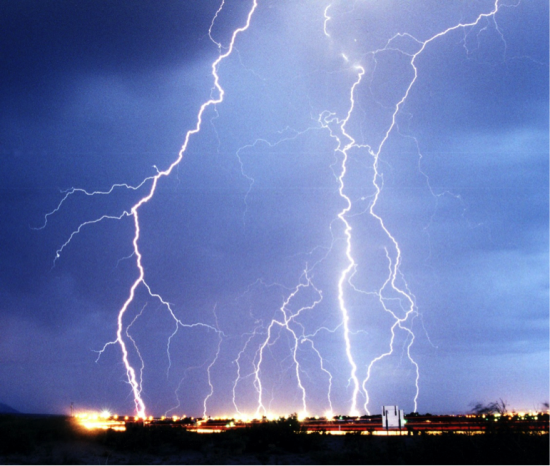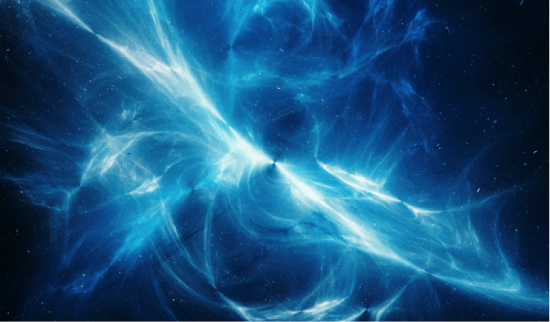
Not If, But When: Cosmology in Crisis
& The Coming Paradigm Shift, Part 3
by Ghada Chehade, PhD
In the previous two articles, I explored cosmology’s broader cultural impact and Thomas Kuhn’s concept of paradigm shift, as it pertains to cosmology and the present cosmological crisis. In this final article of the series, I introduce the Electric Universe as an alternative cosmological model, within the larger framework of Kuhn’s analysis. I do not go into great detail here, since the Electric Universe Model (EUM) as an alternative—and oppositional—cosmological model will be the focus of the next article series.
The Electric Universe Model
The primary principle of the EUM is that the universe’s nature can be better explained by electromagnetism than it can by gravity alone. Though not replacing gravity, the Electric Universe Model adds the essential role of charged particles in motion. Charged particles fill all of space as electrically conductive plasma.1 Contrary to popular belief, the Electric Universe Theory does not dismiss gravity but rather integrates itself with gravitational theory and attempts to answer and explain things that cannot be explained by the gravitational force alone. EUM proponents explain that “when it comes to galaxies and galaxy clusters, over 90 percent of the expected mass for the structures we have observed in the universe is missing should our current understanding of gravity be correct.” This missing expected mass is what caused the theory of dark matter and dark energy to be formed.2
Adherents maintain that there is no need for concepts like dark matter and dark energy with the Electric Universe Model. In this model, electromagnetism is the missing 90% and the missing piece of the cosmological puzzle. Drawing on plasma cosmology, which was proposed by plasma physicist and Nobel Prize winner Hannes Alfven, the Electric Universe Model holds that 99.999 percent of all matter in the observable universe is plasma, and that plasma cosmology eliminates the need for dark matter.3
Proponents of the EUM point out that space-age technology is increasingly allowing scientists to observe the electric nature of the cosmos:
“New observational tools enable us to ‘see’ formerly-invisible portions of the electromagnetic spectrum, and the view is spectacular….Standing out amidst an avalanche of new images is the greatest surprise of the space age: evidence for pervasive electric currents and magnetic fields across the universe, all connecting and animating what once appeared as isolated islands in space. The intricate details revealed are not random, but exhibit the unique behavior of charged particles in plasma under the influence of electric currents.” 4

As one observer notes in an online video on alternative cosmological models: “Even if the Electric Universe Model is not correct, plasma could well be the most abundant form of ordinary matter in the universe, should dark matter be an incorrect hypothesis” (to date dark matter is not a proven hypothesis.) It is possible that the space between galaxies and galaxy clusters could contain large amounts of plasma. Plasma reacts very strongly to magnetic fields, and moving plasma has its own magnetic field and electrically charged currents. “As a result, all the energy generated by plasma would be extremely common throughout the universe. This electricity then reacts with other currents and forms everything we see in the visible universe today.” 5 Simply put, according to the EUM, the most important building block of the universe is plasma.6
Given that evidence of electricity is everywhere, EUM proponents maintain it is not hard to entertain the thought that it plays a key role in everything, “from right here on earth to the farthest reaches of the known universe.” 7 Electricity and electric currents are not foreign concepts. EU scientists hold that since most people are familiar with electricity and how it functions; electricity provides a starting point that most individuals can more easily wrap their heads around. Dark matter and dark energy allow no such clarity or comprehension. For EUM scientists and proponents, “when you see something everywhere you look, its pervasiveness becomes difficult to ignore.” 8
Overall for plasma cosmology and the Electric Universe Model, the most important building block of the universe is plasma, not gravity. As one online commentator notes: “Every star you see is an electrically powered plasma discharge. Every galaxy is the energy source of all its stars. And what joins all this into a universal system is a network of filaments of plasma. You don’t really need anything else.” 9
Resistance to the Electric Universe

Despite the pervasiveness of electrically charged plasma in the universe, the Electric Universe Theory is largely dismissed and at times ridiculed by mainstream cosmology.10 For EU proponents it seems odd that something that is recognized as being so pervasive (i.e., plasma and electromagnetism) is ignored or dismissed by mainstream cosmology and astrophysics. However, when viewed through the lens of Thomas Kuhn’s paradigm shift model, mainstream resistance to new or different cosmological ideas becomes easier to understand.
Dismissing or ridiculing the EUM says more about the nature of Institutionalized Science (what Kuhn calls normal science) than it does about the veracity of the Electric Universe Model. While one might expect science to be open to and welcome new and potentially better explanations and theories, according to Thomas Kuhn, this is not how science functions. In The Structure of Scientific Revolutions Kuhn famously argued that, in reality, science is not open to falsification and looking to nature—as it should—for solutions to its crises (p.77). Instead, science functions much like the Institution of Politics, in that it is hegemonic and dogmatic, and interested in maintaining its power. For Kuhn, dominant science is Orwellian and written by the powers that be (p.166). And much like politics, science is forced to change through revolutions (pp. 92-94). In the case of science, however, revolution is marked by changes in ideas and the emergence—and success—of new theories and paradigms, and not by mass protest, violence, and/or armed struggle.
In reality, dominant science not only functions like politics, but it also appears to serve politics. For instance, in the February 2021 issue of Scientific American there is an article entitled: “Now Is the Time to Reestablish Reality.” While this article appears in the definitive scientific publication in the United States, it has nothing to do with science. Rather, the article argues that there is an urgent need to re-establish public faith in mainstream media and politics and to re-establish political legitimacy following the 2020 presidential elections.12 Essentially, the article is arguing for a need to restore public trust in—and thereby the dominance and hegemony of—mainstream politics/political parties and mainstream media in the United States. What does any of this have to do with science?
If you believe that science is about the objective, empirical pursuit of scientific truth and knowledge, then it has very little to do with science. But if you believe, as Thomas Kuhn implied, that institutional or normative science is linked to or reinforces power and hegemony then it is not all that surprising.
Given the article’s admittance that mainstream political media has lost public support, and given the fact that most people tend to see science as the benign arbiter of truth and facts, it is not surprising—from a political science point of view—that such arguments are being made in science magazines rather than in The New York Times or The Washington Post, since the general public may still “trust science.” Interestingly, whereas mainstream media has long been used to bolster and disseminate dominant or mainstream science, now we see that mainstream science is being used to bolster mainstream media and mainstream political narratives.

Under the above understanding of science—as institutionalized, hegemonic, dogmatic, and in the service of power—resistance to new ideas and theories is not surprising; it is to be expected. Scientists are only human after all, and once humans have power and prestige, be it political or scientific/scholastic, they tend to want to hold onto it. Ironically, however, it is this very resistance to new ideas that eventually forces science to change.
As Kuhn explains, by resisting novelty, normal science (or dominant science) prepares the way for its own change (p.65), not least because crises left unresolved eventually force individuals to look elsewhere for new and better answers and/or explanations. While the dominant model may initially resist, dismiss, or mock the new model, failure to address the crises the new model or paradigm seeks to remedy eventually forces the dominant model to yield to the new. This does not happen overnight but, eventually, the crises in the old model become so big and so detrimental to the field, that the theory is forced to change, and a new paradigm emerges.
For Kuhn, new models demand the destruction of the old paradigm. The new paradigm does not simply revise the old model, it replaces it. This happens partly because different paradigms speak different languages and do not see the world the same, even though they are working in the same field or discipline (p.103). As such, they are irreconcilable. There is an inherently incompatible—and oppositional13—dynamic that is set up between the two different paradigms, not least because the dominant model is not able to understand the new model though the new model can understand the language of the old model, even if it does not agree with it.
For an example of how irreconcilable the Big Bang and Electric Universe theories are, the Electric Universe Model does not support nor require a relativistic component–i.e. a foundational paradoxical theoretical basis, and the consequent general acceptance of paradoxical thinking that permits and shields itself in ‘weirdness’ at the expense of critical self-scrutiny. While the EUM understands the language of relativity, it does not use this language in its approach to cosmology, and indeed rejects and opposes it.14 This harkens back to points raised in parts one and two of this series about a) how Einstein’s theory of relativity influenced the social sciences and humanities and gave rise to cultural relativism and b) how Big Bang cosmology celebrates cosmological “weirdness.” One might expect that if an Electric Universe paradigm were to one day supplant the Big Bang model, this could potentially reverse some of the broader socio-cultural relativism that has been indirectly fostered through Big Bang cosmology and astrophysics, but that is a topic for another article.

To return to the previous point about the destruction of the old paradigm, paradigm shifts often only fully happen when the proponents of the old paradigm die-off or retire. The German physicist Max Planck said that science advances one funeral at a time. Or more precisely: “A new scientific truth does not triumph by convincing its opponents…but rather because its opponents eventually die, and a new generation grows up that is familiar with it.” 15
While the old model and its proponents usually have to die-off for change to fully happen, sometimes individuals working within the old model do “convert” to the new theory. One example is Benjamin Hyde, a television news science presenter at KSTU-FOX-13 Salt Lake City and social media creator. Hyde is a former Big Bang adherent that grew disillusioned with the Big Bang theory and embraced the Electric Universe Model as a better and more coherent model; one he now teaches to the young and curious on his various platforms.16 In an interview with Space News, Hyde explains that he had been studying physics for over two decades and would get burnt out often because, ultimately, the Big Bang theory just did not give him many answers, and did not make sense. He explains:
“I remember specifically a few years ago, when dark matter and dark energy really hit the stage, and I learned that 96.5 percent, or whatever it is, of the known universe was either dark matter and dark energy….I thought wow, that is a profound amount of stuff in the universe that we don’t know anything about.” 17
Commenting on the burn out he would experience with the Big Bang theory, Hyde notes:
“Looking back on it, I realize that was because I was studying nonsense…I was trying to bang this…stuff into my head; and there was a part of my head that was just saying, you know Ben, this isn’t real you know, this is a mistake….After one of these up and down times with quantum physics, I went into the Electric Universe and became enthralled… I learned what they had to say and it was just captivating.…this feeling of…oh finally all the stuff we’ve been studying our whole lives, now finally makes sense….We don’t know everything. And there’s still questions clearly, but it feels like we’re on the right path [with the Electric Universe Model].” 18
Final Thoughts
This is just one example of a Big Bang-trained scientist converting to the Electric Universe Model. There are many more out there and the number may increase as the crisis in Big Bang cosmology continues to grow and become more apparent, and as the EUM continues to offer what many see as simpler and arguably better answers to the “mysteries of the universe.”
Wallace Thornhill, a pioneer of the Electric Universe Model, once called Albert Einstein one of the perpetrators of the demise of physics.19 Depending on how one feels about abstract art, moral and cultural relativism, and identity politics—things identified in part one as having been influenced or engendered by the application of relativity to the social sciences and the broader culture—some may also argue that Einstein has unknowingly been a perpetrator of the demise of classical art, normative morality, non-paradoxical thinking, and social cohesion. Such has been the far-reaching impact of the standard model and its related theories and concepts.
We still do not know what the future of cosmology will be. Given the previous articles—and the crisis in big bang cosmology—it is unlikely that it will be a Big Bang future. But what might replace it we still cannot know for certain. New theories could emerge that take scientists in yet unimagined directions. This three-part article merely opens a discussion on the Electric Universe Model as a possible alternative.

If and when the Big Bang paradigm gives way to a new one—and in the case of the Electric Universe paradigm, its proponents hold that it is a new model that harkens back to some of the lost or ignored knowledge and wisdom of the pre-Big Bang past20—one can only imagine how this new paradigm could impact and shape both cosmology and the broader culture. If the new model is an electric universe paradigm, for starters, its proponents believe that the EUM may bring much-needed hope to cosmology.
Wallace Thornhill has argued that standard Big Bang cosmology is a hopeless cosmology, which “gives a distorted view of the universe” that “evokes a sense of lonely bodies in space, isolated galaxies, self-immolating stars drifting like dust moats in the blackness and the clockwork solitude of planets.” In challenging this idea, Thornhill explains that “the Electric Universe emphasizes connectivity: The electric force influences matter at all levels, from subatomic particles to galactic clusters, leaving little room for the disconnected fragments of modern theory.” 21
If the dictum “as above so below” holds any truth, one may expect that a shift towards a more hopeful and connected cosmology could one day impact the broader culture and society in a manner that ushers in a more connected and more hopeful view of humans and our place in, and connections to, the cosmos and each other. These topics will be explored in future articles.
For now, I want to conclude that—considering what was explored in all three articles—a cosmological crisis, and a burgeoning cosmological revolution/paradigm shift, appear to be presently upon us. While we do not yet know what the new paradigm will be, given all of the ways that cosmology and astrophysics impact the broader culture and society, it is a very interesting time to be alive, to say the least.
A new and hopeful cosmology—and the broader cultural changes this could eventually engender—may be just what we need in the midst of the global fear and uncertainty that has been ushered in by the Covid-19 situation, and far beyond.
NOTES
1 https://www.thunderbolts.info/wp/2013/09/16/chapter-1-beginners-guide/
2 https://www.youtube.com/watch?v=Uzw6s4nbTZA&feature=emb_logo
3 Ibid.
4 https://www.thunderbolts.info/wp/2011/09/02/essential-guide-to-eu-introduction/
5 https://www.youtube.com/watch?v=Uzw6s4nbTZA&feature=emb_logo
6 Taken from a comment by Chris Philips on the online platform Quora (December 28 2019)
7 https://www.youtube.com/watch?v=Uzw6s4nbTZA&feature=emb_logo
8 Ibid.
9 Taken from a comment by Chris Philips on the Quora Platform (December 28, 2019)
10 https://www.youtube.com/watch?v=Uzw6s4nbTZA&feature=emb_logo
11 Kuhn, T.S. (1962). The Structure of Scientific Revolutions. Chicago: The University of Chicago Press.
12 https://www.scientificamerican.com/article/now-is-the-time-to-reestablish-reality/
13 In openly questioning the Big Bang as a construct that refuses to yield to falsification (as empirical science should), the Electric Universe Theory self-consciously situates itself as an oppositional model, that not only questions the scientific veracity of the Big Bang Theory but also problematizes how it functions hegemonically to maintain its dominance. As such, the Electric Universe Theory works seamlessly with Kuhn’s broader critical analysis. This is among the topics I will explore in the next article series.
14 https://www.youtube.com/watch?v=xxaP91FdijU
16 https://www.youtube.com/watch?v=Aj2Tn3H6Qv4
17 https://www.youtube.com/watch?v=Aj2Tn3H6Qv4
18 Ibid.
19 https://www.youtube.com/watch?time_continue=63&v=AFcNHHxSFl4&feature=emb_logo
20 A point I will explore in future articles.
21 https://www.youtube.com/watch?v=xxaP91FdijU
Copyright © 2021 Ghada Chehade. All content in this article is the sole property of the author and can only be reproduced with the expressed permission of the author, Ghada Chehade.

Dr. Ghada Chehade is an award-winning writer, social critic and performance poet. She spent over a decade as a political analyst, specializing in geopolitics and the study of socio-political change. Her articles and essays have been published in international publications such as Asia Times, The Political Anthropologist, and The Global Analyst. She recently broadened her focus to include an analysis of how changes in science and cosmology impact the larger culture. Dr. Chehade holds a Bachelor’s degree in Political Science, an MA in Communication Studies and a PhD in Discourse Analysis, from McGill University. Her doctoral research won the award for Best Dissertation from the Canadian Association for the Study of Discourse and Writing and was funded by the Social Sciences and Humanities Research Council.
Dr. Chehade’s earlier articles on the Electric Universe model can be found at soapbox-blog.com.
Email info@ghadachehade.com
The ideas expressed in Thunderblogs do not necessarily express the views of T-Bolts Group Inc. or The Thunderbolts Project.












